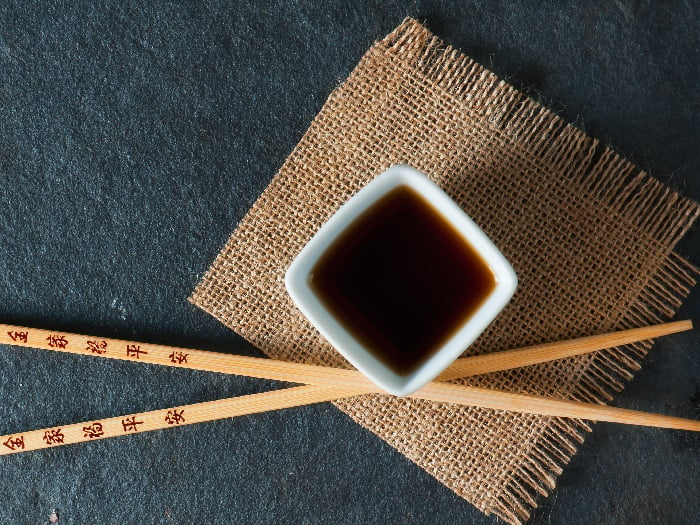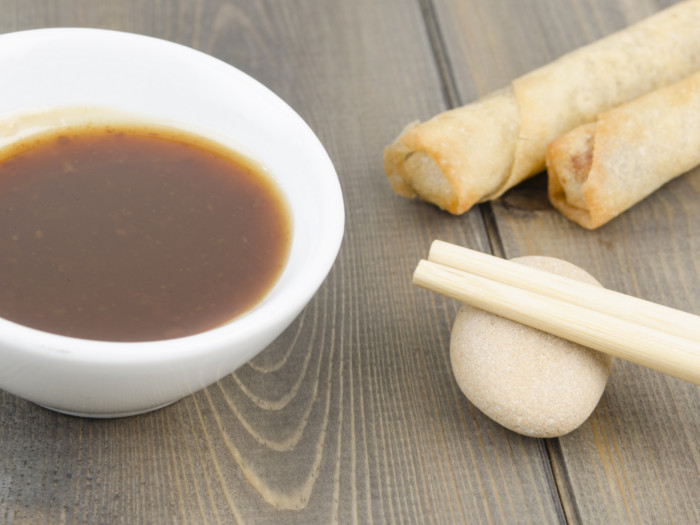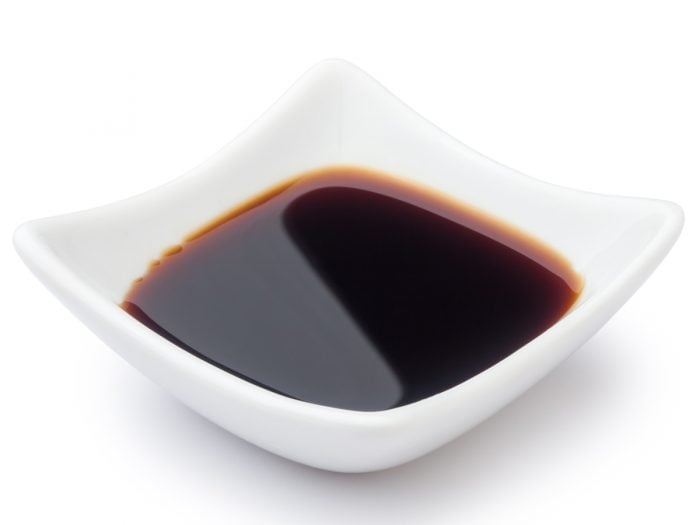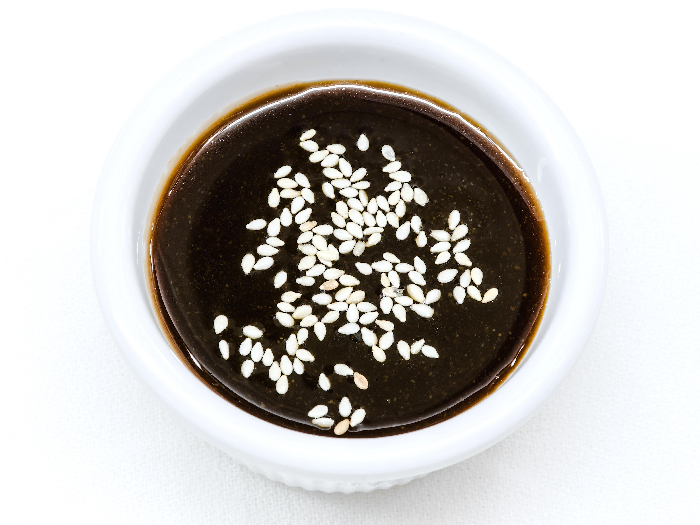Hoisin sauce is a reddish-brown tangy condiment that is commonly used in Chinese and Vietnamese cuisine, both as an ingredient in meals and as a dipping sauce.
What Is Hoisin Sauce?
Hoisin sauce is a thick smooth sauce, similar in consistency to American barbecue sauce, which is commonly used to glaze meats and plays a key role in many traditional Chinese and Vietnamese dishes. It is both sweet and salty and is traditionally made with fermented soybean paste as the base. However, there are many different varieties of this sauce that utilize different ingredients, including vinegar, brown sugar, fennel, soy sauce, garlic, five-powder spice, rice wine vinegar, sesame oil, black pepper, and hot sauce, among others. Although the word “hoisin” translates to seafood, there are no seafood elements in the sauce, and the name is believed to come from its occasional usage in seafood dishes. [1]

A flat lay shot of chopsticks resting across a small bowl of hoisin sauce. Photo Credit: Shutterstock
Serving Size : Nutrient Value Water [g] 44.23 Energy 220 Energy [kJ] 920 Protein [g] 3.31 Total lipid (fat) [g] 3.39 Ash [g] 4.98 Carbohydrate, by difference [g] 44.08 Fiber, total dietary [g] 2.8 Sugars, total including NLEA [g] 27.26 Calcium, Ca [mg] 32 Iron, Fe [mg] 1.01 Magnesium, Mg [mg] 24 Phosphorus, P [mg] 38 Potassium, K [mg] 119 Sodium, Na [mg] 1615 Zinc, Zn [mg] 0.32 Copper, Cu [mg] 0.13 Manganese, Mn [mg] 0.25 Selenium, Se [µg] 1.8 Vitamin C, total ascorbic acid [mg] 0.4 Thiamin [mg] 0 Riboflavin [mg] 0.22 Niacin [mg] 1.17 Pantothenic acid [mg] 0.07 Vitamin B-6 [mg] 0.06 Folate, total [µg] 23 Folate, food [µg] 23 Folate, DFE [µg] 23 Choline, total [mg] 8 Carotene, beta [µg] 4 Vitamin A, IU [IU] 6 Lutein + zeaxanthin [µg] 45 Vitamin E (alpha-tocopherol) [mg] 0.28 Vitamin K (phylloquinone) [µg] 0.5 Fatty acids, total saturated [g] 0.57 16:0 [g] 0.37 18:0 [g] 0.17 Fatty acids, total monounsaturated [g] 0.96 18:1 [g] 0.96 Fatty acids, total polyunsaturated [g] 1.7 18:2 [g] 1.52 18:3 [g] 0.18 Cholesterol [mg] 3 Sources include : USDA [2]
Hoisin Sauce vs Oyster Sauce
While hoisin sauce and oyster sauce share a number of characteristics, there are some critical differences in these two popular sauces.
- Ingredients: Hoisin sauce is made using soy sauce, honey, sesame oil, black pepper, water, sugar, garlic, salt, rice vinegar among others. Oyster sauce, on the other hand, is commonly made from oyster, water, sugar, and salt, along with various other thickeners and artificial flavors. Hoisin sauce is a great vegan option but it is always advisable to check the ingredients list to be on the safe side.
- Taste: Hoisin sauce is spicy, sweet and salty, all at the same time. The soybeans, sesame oil, chili and vinegar in this sauce give it a more palatable and complex taste. Unlike soy sauce, the saltiness doesn’t overwhelm the other flavors of a dish. Oyster sauce, on the other hand, is saltier. In high-end varieties, the oyster or fish flavor will be subtle, but cheaper versions will strongly taste of the sea. [3] [4]
- Consistency: Oyster sauce has a thinner consistency as compared to hoisin sauce.
- Uses: Hoisin sauce can be used to make different glazes, mayos, and vinaigrettes, and is also commonly used as a table condiment or dipping sauce. Oyster sauce is dark brown in color and is excellent for stir-fries as it coats vegetables and meat nicely, though not as a glaze.
Uses
This sauce has traditionally been used in Chinese and Vietnamese cooking, both in stir-fries and as a glaze for meat dishes. It is particularly popular for pork dishes and duck wraps. In Vietnam, hoisin is often included with pho, either in the soup itself, or as a dipping sauce for the meat, or for spring rolls. The sauce adds a wonderful flavor to noodle dishes and can be included in many different sauces and vinaigrettes. [5]

Homemade Hoisin Sauce Recipe
Ingredients
- 1 tbsp dark brown sugar
- 1/4 cup soy sauce
- 2 tbsp peanut butter
- 2 tsp rice wine vinegar
- 1 tbsp sesame oil
- 1 clove garlic
- 1/4 tsp black pepper (ground)
- hot sauce (To taste)
Instructions
- Add all ingredients to a large bowl and whisk until the consistency is smooth.

- Taste the sauce and add extra spices or vinegar, as needed. Garnish with sesame seeds (optional)

- Serve at room temperature or slightly chilled.
Hoisin Sauce Substitutes
If you don’t have hoisin sauce on hand, and you don’t want to make your own, there are a few options in the kitchen that can mimic the consistency or flavor of this sauce.
- Oyster sauce: It is a great replacement if you’re planning to use hoisin with a seafood dish, whereas you will want to use tamari sauce or soy sauce for vegetable dishes, stir-fries, and noodles.
- Duck sauce: It can replace hoisin as a table condiment or dipping sauce.
- Barbecue sauce: As a glaze for meat dishes, barbecue sauce is an excellent option.
- Other: There are some easy recipes for replacement flavors, such as combining barbecue, molasses and soy sauce, or blending a cup of boiled prunes with soy sauce and two cloves of garlic.
Whatever replacement you choose, it won’t be a perfect match to the unique flavor of hoisin, but it should still make for a delicious meal!


